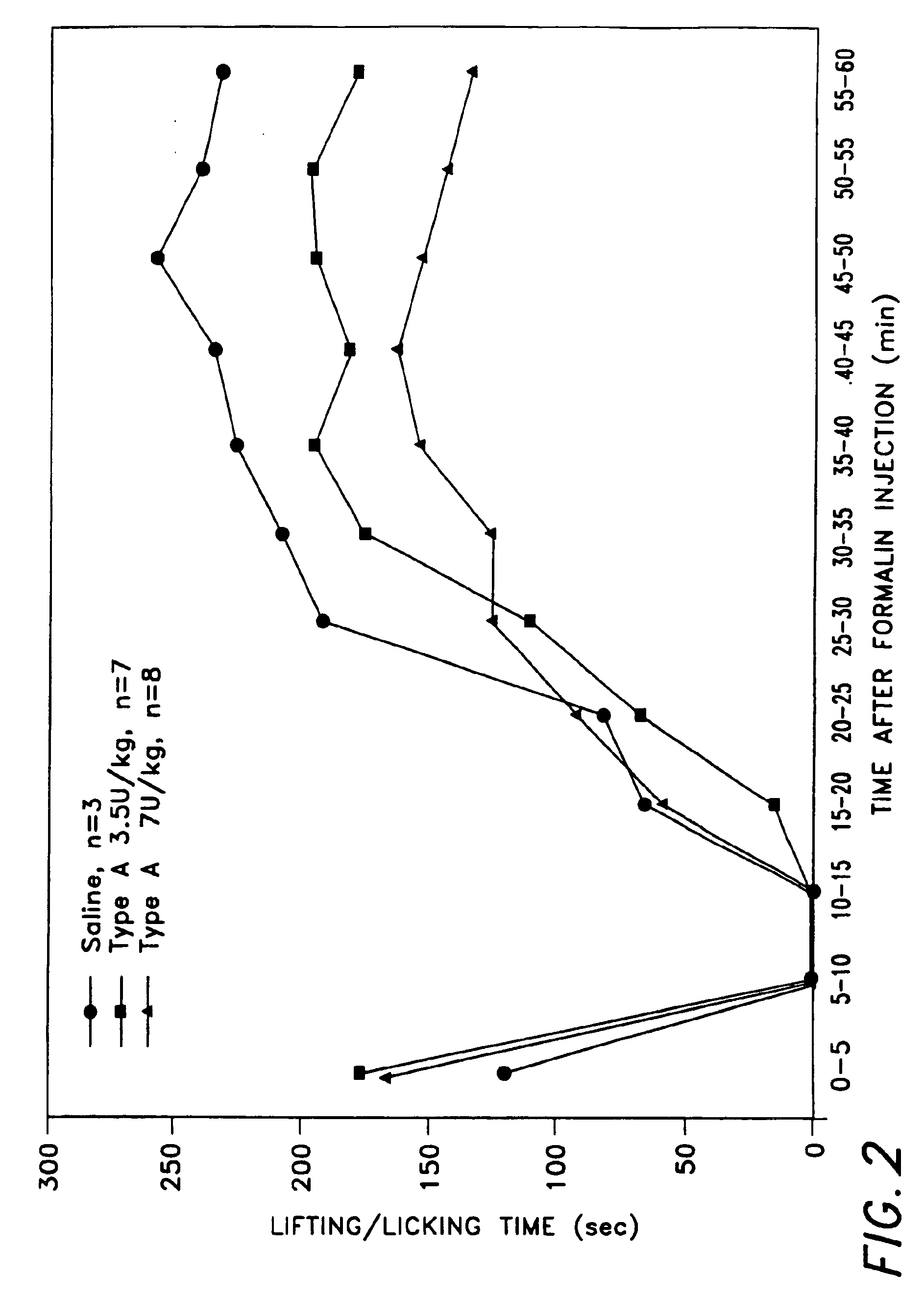Pain treatment by peripheral administration of a neurotoxin
a neurotoxin and peripheral administration technology, applied in the field of treating pain, can solve the problems of limiting function, body pain, and ineffective treatment of pain, and achieve the effect of long-lasting, non-surgical, and effective treatmen
- Summary
- Abstract
- Description
- Claims
- Application Information
AI Technical Summary
Benefits of technology
Problems solved by technology
Method used
Image
Examples
example 1
Pain Alleviation by Peripheral Administration of Botulinum Toxin Type A
Two experiments were carried out. Sprague-Dawley rats (about 300 to about 350 grams) were used in both experiments. The neurotoxin used in both experiments was BOTOX® (botulinum toxin type A purified neurotoxin complex). In the first experiment there were 4 treatment (dose) groups: control (saline injected) rats (n=4), 7 U BOTOX® / kg rats (n=8), 15 U BOTOX® kg rats (n=5), and 30 U BOTOX® / kg rats (n=4). For the control rats, 25 microliters of 0.9% saline solution was injected subcutaneously into the plantar surface of the animal's hind paw. The site and route of administration of BOTOX® was the same as for the saline injection control group.
Five days after either the saline or BOTOX® injection, 50 microliters of 5% formalin was injected at the site on each of the rats in all four groups where either saline or BOTOX® had been previously injected. Limb lifting / licking by the subject animals was then recorded at 5 min...
example 2
Peripheral Administration of a Botulinum Toxin to Alleviate a Non Spasm Pain
A 46 year old woman presents with pain localized at the deltoid region due to an arthritic condition. The muscle is not in spasm, nor does it exhibit a hypertonic condition. The patient is treated by a bolus injection of between about 50 Units and 200 units of intramuscular botulinum toxin type A. Within 1-7 days after neurotoxin administration the patient's pain is substantially alleviated. The duration of significant pain alleviation is from about 2 to about 6 months. A pain in the shoulder, arm, and hand due to osteoporosis, fixation of joints, coronary insufficiency, cervical osteoarthritis, localized shoulder disease, or due to a prolonged period of bed rest can be similarly treated.
example 3
Peripheral Administration of a Neurotoxin to Treat Postherapeutic Neuralgia
Postherapeutic neuralgia is one of the most intractable of chronic pain problems. The patients suffering this excruciatingly painful process often are elderly, has debilitating disease, and are not suitable for major interventional procedures. The diagnosis is readily made by the appearance of the healed lesions of herpes and by the patient's history. The pain is intense and emotionally distressing. Postherapeutic neuralgia may occur any where, but is most often in the thorax.
A 76 year old man presents a postherapeutic type pain. The pain is localized to the abdomen region. The patient is treated by a bolus injection of between about 50 Units and 200 units of botulinum toxin type A subcutaneously to the abdominal region. Within 1-7 days after neurotoxin administration the patient's pain is substantially alleviated. The duration of significant pain alleviation is from about 2 to about 6 months.
PUM
| Property | Measurement | Unit |
|---|---|---|
| molecular weight | aaaaa | aaaaa |
| molecular weight | aaaaa | aaaaa |
| mechanical | aaaaa | aaaaa |
Abstract
Description
Claims
Application Information
 Login to View More
Login to View More - R&D
- Intellectual Property
- Life Sciences
- Materials
- Tech Scout
- Unparalleled Data Quality
- Higher Quality Content
- 60% Fewer Hallucinations
Browse by: Latest US Patents, China's latest patents, Technical Efficacy Thesaurus, Application Domain, Technology Topic, Popular Technical Reports.
© 2025 PatSnap. All rights reserved.Legal|Privacy policy|Modern Slavery Act Transparency Statement|Sitemap|About US| Contact US: help@patsnap.com


